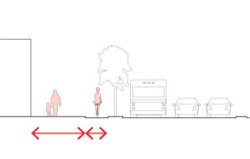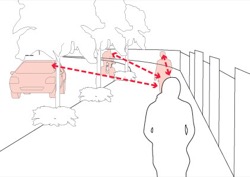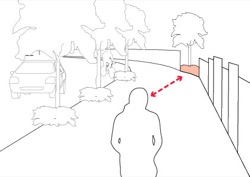On this page:
About major roads
Major roads accommodate high volumes of motor vehicle traffic including public transport and freight, and have higher design speeds, 60–100 km/h.
Major roads can have two or more traffic lanes in each direction and may provide for on–street car parking, bus lanes or tram tracks, bicycle lanes, as well as verge space for pedestrian paths, infrastructure and landscaping.
Major roads may be identified as priority routes for public transport, motor vehicle traffic or freight. Larger major roads that are declared arterial roads are managed by VicRoads.
Pedestrians and cyclists, while accommodated on these roads, may be given a lower priority in terms of access and amenity while maintaining a high level of safety. A section of an arterial road through an activity centre or school zone may have lowered design speeds.
Why is it important?
Major roads carry large volumes of people and goods over longer distances. While they provide connections between major centres of population, regions and transport terminals, they also function as local area connections for all modes.
Major roads sometimes lie within centres of high activity, where they may function as pedestrian priority routes to pedestrian priority places with periods of lowered traffic speed limits for a section of their length.
This element focuses on safe and convenient travel for pedestrians and cyclists on major roads.
This element does not cover design of motorways and railways.
2.5.1: ensure the safety and amenity of pedestrians and cyclists along major roads
VicRoads is a referral authority for all landscape treatments and works adjacent to arterial roads.
- Provide separate paths for pedestrians and cyclists travelling beside major roads.

Tip: bicycle paths along major roads may cater for commuter cyclists as well as school children and recreational cyclists. See Element 2.3 Pedestrian and bicycle paths. - Position pedestrian and bicycle paths to achieve clear sightlines along paths and from the roadway to the path.

Tip: landscape elements such as trees, fences or earth mounds can provide safety and amenity to pedestrians and cyclists travelling alongside major roads so long as road safety and opportunities for informal surveillance are maintained. - Where major roads are bordered by existing rear fences and walls, provide pedestrian and bicycle paths with clear sightlines to visible exit paths.

Tip: isolated paths bordered by blank walls or fences and with few opportunities for ‘escape routes’ or for informal surveillance from overlooking buildings can feel unsafe and can increase opportunities for entrapment of walkers. - Provide for noise attenuation and safety treatments on pedestrian and bicycle paths along high noise, high–speed, high–volume major roads.
- Provide safe and direct pedestrian and bicycle crossings on major roads.
Tip: refer to 2.4 Pedestrian and bicycle crossings.
2.5.2: ensure safe, convenient pedestrian access from neighbourhoods to public transport stops on major roads
- Locate public transport stops and pedestrian approach paths on major roads where there are opportunities for informal surveillance.
- Provide safe and direct crossings of major roads in locations that enable pedestrians of all abilities to reach public transport stops.
Tip: refer to 2.4 Pedestrian and bicycle crossings and 2.6 Public transport on roads.
Page last updated: 28/10/25